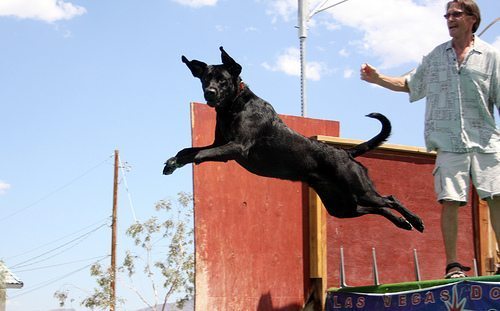 When you think of exercising your dog, the first thing that likely comes to mind is going on a walk. Daily walks are an essential part of having a dog. Walks provide an excellent way to maintain your dog’s fitness level, relieve their boredom, and keep their potty schedule regular. If your schedule permits, frequent, shorter walks are better than one long walk per day.
When you think of exercising your dog, the first thing that likely comes to mind is going on a walk. Daily walks are an essential part of having a dog. Walks provide an excellent way to maintain your dog’s fitness level, relieve their boredom, and keep their potty schedule regular. If your schedule permits, frequent, shorter walks are better than one long walk per day.
However, depending on your dog, a daily walk may not be enough. Often, the dog is restricted by your pace. The dog must keep a shorter, more consistent stride to stay in line with you, either walking or trotting. Unless you incorporate intervals into your daily walk, the dog is likely not getting the opportunity to “stretch out” his gate and challenge his fitness level.
Some dogs just need more exercise and variety. How much will depend on several factors unique to your dog – her age, breed, personality, activity level, amount of energy, coat type and more. The same way that people integrate multiple activities into their exercise regimen to prevent boredom and injury, pets can benefit from incorporating new activities too. “Cross training” can help your dog improve his fitness level, acquire new skills and bond more closely with his favorite person (you!). Below are a few ideas on how to change up your dog’s fitness routine from time to time.
Swimming
Some breeds, such as Labrador Retrievers and English Water Spaniels, are natural swimmers, taking to the water like fish. For others, it may be an acquired taste. Swimming can be an excellent way for your dog to stay active with minimal wear and tear on his joints. Water also soothes the nervous system and increases relaxation, especially helpful in cases where does must undergo physical rehabilitation.
It’s best to start out slowly if your dog is not familiar with swimming. Start in calmer waters, such as a pool or lake, until you know how your dog will do. Take them to a quiet area, support their weight at first (oddly enough, the “doggy paddle” does not come naturally to all dogs) and maintain a watchful eye on them at all times.
Dock Diving
This might be considered the “extreme sports” offshoot of swimming. Not for the faint of heart, this sport consists of dogs taking great leaps from docks and into water. Success is measured by speed, jump distance and often height. Check out the world record holder at: http://www.youtube.com/watch?v=kDMAmMy_OqU
Off-leash Running
Finding the opportunity to let your dog off leash occasionally will pay dividends for her health. However, as the recent recipient of a $50 ticket, I should advise you to make sure you are in an area where off leash dogs are permitted! Off the leash, dogs have more opportunities to run across varied terrain, which strengthens and tones different muscle groups. Also, they are not constrained by your (human) pace, and will naturally vary their pace between trotting and galloping, increasing their fitness level by adding intervals. Assuming your dog can pass the temperament test, dog parks are great for this purpose, and they add a social element.
Agility
Agility training is a natural boredom buster for dogs. In agility, dogs compete through obstacle courses, judged both on time and accuracy. Obstacles might include tunnels, jumps, ramps, see-saws, weaving poles and much more. Like show jumping with horses, the competition is very much a partnership between animal and human. The dogs rely on the body language of their human partners to direct them where to go next. Many agility classes and clubs exist, as the sport has exploded in popularity in the past twenty years, but all experts agree that it is best to start with basic obedience classes to begin developing the relationship and bond required to be successful at agility.
Wing It!
If you do not have the time to invest in these new activities, or your dog appears to be a “one trick pony”, you can still easily change up your usual routine. At a minimum, try to incorporate intervals into your daily walks – adding short bursts of speed, or hill runs. Be sure to change the course you take on a regular basis. Even backyard play can increase your dog’s fitness level. According to K9 magazine, even 5 minutes of tug-of-war play can count for as much as 15 minutes of a walk!
Your dog’s fitness level depends on your creativity. Finding ways to incorporate new sports, or even just new activities within your existing walks and backyard play, can go a long way to keeping your dog healthy and happy throughout her lucky life with you.
Photo: Courtesy of feeferlump via Flickr (CC by 2.0)









